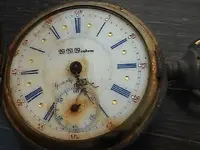You are using an out of date browser. It may not display this or other websites correctly.
You should upgrade or use an alternative browser.
You should upgrade or use an alternative browser.
Pocketwatch
- Thread starter lucky1777
- Start date
Nana40
Gold Member
Great watch Lucky!


Gypsy Heart
Gold Member
Really a pretty watch Lucky...but I dont know if its real jewels. The WW Windom could be the name of the owner who the watch was made for. Not the company. Alot of times,people paid the watchmaker to put their names on the watch face. i would take it to a watch repairman and have it checked out. It is a great find tho!
-MURPH-
Full Member
- Joined
- Apr 25, 2005
- Messages
- 242
- Reaction score
- 5
- Golden Thread
- 0
- Location
- DUI=digging under the influence
- Detector(s) used
- whites-DFX
- Primary Interest:
- All Treasure Hunting
very nice HH
nevrdundetecting
Sr. Member
- Joined
- Sep 26, 2005
- Messages
- 317
- Reaction score
- 53
- Golden Thread
- 0
- Location
- Wayne Co., WV
- Detector(s) used
- Minelab Equinox 600, White's Prizm III, Bounty Hunter Pioneer EX
Pro-Find 15 pinpointer
- Primary Interest:
- Metal Detecting
doesn't the number of jewels refer to the movement of the watch? the more jewels, the more accurate the watch is....as you know most modern watches are quartz movement
here's something that I found on another RR watch...sounds like it was probably a pretty expensive watch
"Third, and perhaps most impressively, this watch has a whopping 24 RUBY JEWELS!!! Now, we all know that railroad pocket watches didn't really NEED more than 21 jewels [for that matter, they probably didn't need more than 17 jewels to be as accurate as they were], but the extra jewels are sort of like the leather interior and the Bose stereo on the best luxury cars."
http://barrygoldberg.net/watch65.htm
awesome find!!
HH
here's something that I found on another RR watch...sounds like it was probably a pretty expensive watch
"Third, and perhaps most impressively, this watch has a whopping 24 RUBY JEWELS!!! Now, we all know that railroad pocket watches didn't really NEED more than 21 jewels [for that matter, they probably didn't need more than 17 jewels to be as accurate as they were], but the extra jewels are sort of like the leather interior and the Bose stereo on the best luxury cars."
http://barrygoldberg.net/watch65.htm
awesome find!!
HH
nevrdundetecting
Sr. Member
- Joined
- Sep 26, 2005
- Messages
- 317
- Reaction score
- 53
- Golden Thread
- 0
- Location
- Wayne Co., WV
- Detector(s) used
- Minelab Equinox 600, White's Prizm III, Bounty Hunter Pioneer EX
Pro-Find 15 pinpointer
- Primary Interest:
- Metal Detecting
here's another link that explains how the jewels are used in the watch movement....
"What are jewels?
Watches have many moving parts, with wheels and pivots and shafts that can cause wear where they are held in place. So instead of metal moving against metal, which would cause friction and wear, watch makers designed jewels which cause very little friction or wear. The jewels can be made of diamonds, sapphires, or most commonly rubies, with a small hole drilled in them to hold the shaft of a pivot or wheel.
More jewels are an indicator of watch quality, in general the higher the jewel count, the less wear and friction the watch will have, and the more accurate and long lasting the timepiece will be.
There are many different kinds of jewels including balance, friction, flat, center, pallet and roller jewels. Each are physically different, but are designed to reduce friction and wear on a moving metal part inside a mechanical watch. Each jewel will help the watch run more smoothly, more accurately and have a longer life. Each jewel adds to the cost and complexity of a watch movement, therefore a watch with more jewels costs more to make and makes the watch more valuable and long lasting."
http://pocketwatcher.zoovy.com/category/watch_information.jewelswhatarethey/
"What are jewels?
Watches have many moving parts, with wheels and pivots and shafts that can cause wear where they are held in place. So instead of metal moving against metal, which would cause friction and wear, watch makers designed jewels which cause very little friction or wear. The jewels can be made of diamonds, sapphires, or most commonly rubies, with a small hole drilled in them to hold the shaft of a pivot or wheel.
More jewels are an indicator of watch quality, in general the higher the jewel count, the less wear and friction the watch will have, and the more accurate and long lasting the timepiece will be.
There are many different kinds of jewels including balance, friction, flat, center, pallet and roller jewels. Each are physically different, but are designed to reduce friction and wear on a moving metal part inside a mechanical watch. Each jewel will help the watch run more smoothly, more accurately and have a longer life. Each jewel adds to the cost and complexity of a watch movement, therefore a watch with more jewels costs more to make and makes the watch more valuable and long lasting."
http://pocketwatcher.zoovy.com/category/watch_information.jewelswhatarethey/
Similar threads
- Replies
- 13
- Views
- 376
- Suggestion
- Replies
- 23
- Views
- 756
Users who are viewing this thread
Total: 1 (members: 0, guests: 1)





